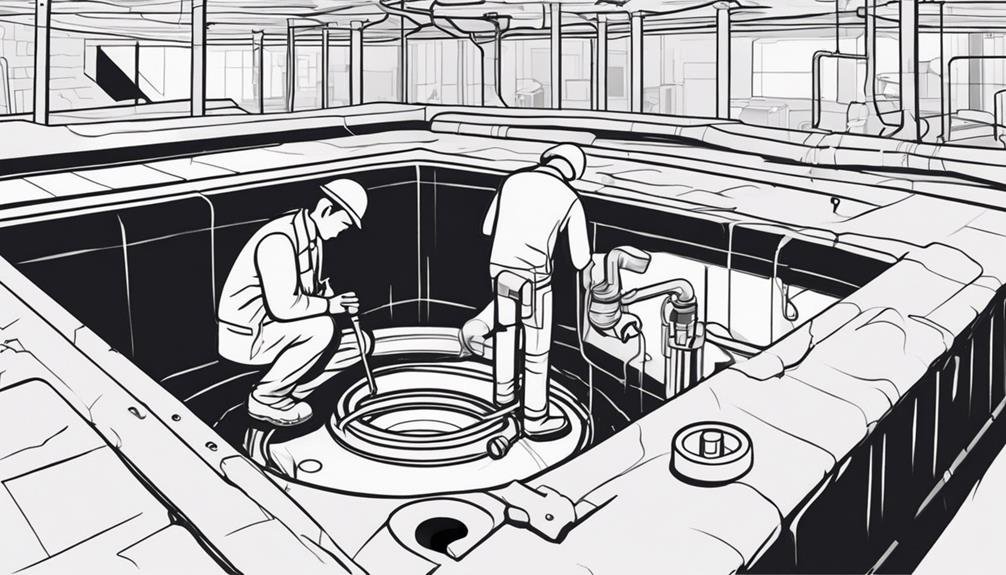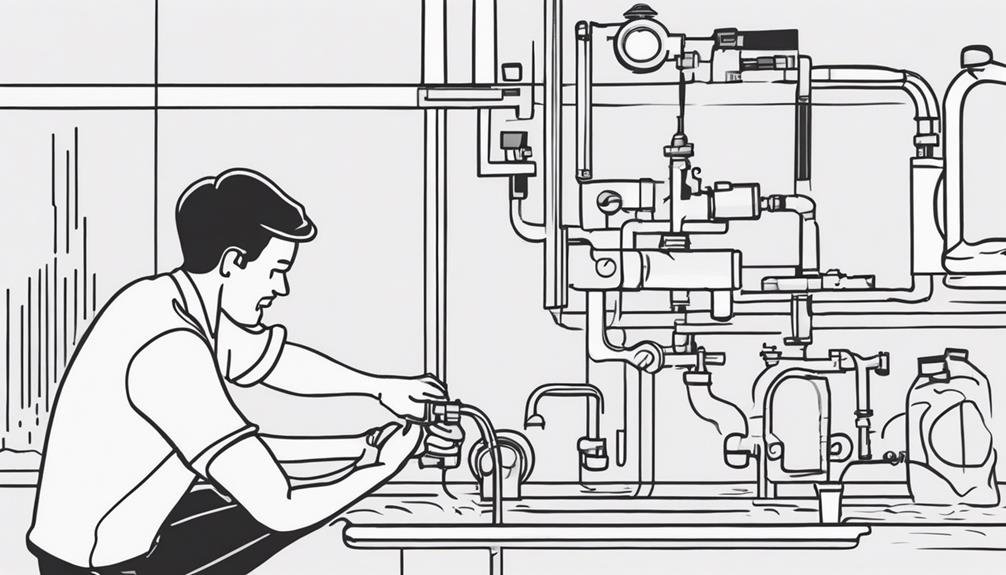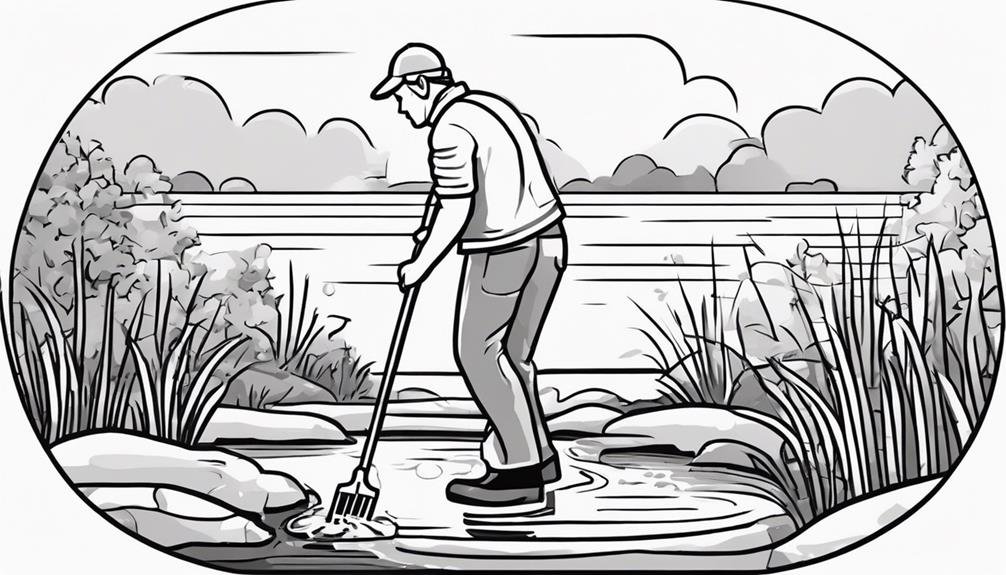Maintaining your septic system is like giving your home's hidden hero the care it deserves. But do you know the simple steps that can save you from potential disasters and costly repairs?
From inspecting the tank and pipes to using septic-safe products, each task plays a crucial role in keeping your system running smoothly.
So, are you ready to discover the key to DIY septic system maintenance and ensure your household functions seamlessly?
Key Takeaways
- Regularly inspect and pump the septic tank every 3-5 years for optimal functionality.
- Monitor water usage to prevent overloading the system and address leaks promptly.
- Use septic-safe products to preserve system health and prevent clogs.
- Maintain drainfield integrity by avoiding root invasion and heavy objects on the area.
Inspect Tank and Pipes

Inspect the septic tank and pipes regularly to ensure proper functioning and prevent potential issues. Tank cleaning is essential for maintaining a healthy septic system. Begin by locating the access ports on your tank. Remove the lids carefully and inspect the contents. If the sludge has accumulated to more than one-third of the tank's depth, it's time for a professional tank cleaning. Excessive sludge can lead to clogging and system failure.
Next, inspect the pipes for any signs of damage or leaks. Pipe repair is crucial to prevent wastewater from seeping into the ground and contaminating the surrounding area. Check for cracks, loose fittings, or blockages. Use a flashlight to look for any visible issues. Addressing pipe problems promptly can save you from costly repairs in the future.
Regular inspections and maintenance are key to ensuring your septic system operates efficiently. By staying proactive with tank cleaning and pipe repair, you can prevent major malfunctions and extend the lifespan of your system.
Pump Out Solids Regularly
To maintain optimal functionality and prevent system issues, routinely pump out solids from your septic tank to ensure efficient operation. Solids accumulation within the tank can lead to clogs, backups, and potential system failures. Regularly scheduled pump-outs, typically every 3-5 years, are essential for proper septic system maintenance.
During a pump-out, a professional will remove the accumulated solids from the tank, preventing them from reaching a level where they could flow into the drain field, causing blockages and reducing the system's effectiveness. This routine maintenance is crucial for prolonging the lifespan of your septic system and avoiding costly repairs.
Monitor Water Usage

Monitoring water usage is a critical aspect of septic system maintenance to ensure optimal performance and prevent overloading the system. Water conservation plays a vital role in preserving your septic system. Be mindful of excessive water usage as it can overwhelm the system, leading to potential issues. Keep an eye out for leak detection both inside and outside your property. Leaks can result in a continuous flow of water into the system, causing unnecessary strain.
To effectively monitor water usage, consider installing water-efficient fixtures and appliances. These can help reduce the overall water consumption in your household. Additionally, practicing good water habits such as fixing leaks promptly and avoiding long periods of water flow can significantly benefit your septic system.
Regularly check your water meter for any unusual spikes in water usage, as this could indicate a leak that needs immediate attention. By actively monitoring and conserving water, you contribute to the longevity and efficiency of your septic system.
Use Septic-Safe Products
Consider selecting cleaning and household products that are labeled as septic-safe to maintain the optimal functionality of your septic system. Using septic-safe products is crucial in preventing damage to your septic system and ensuring its longevity. These products are designed to be gentle on the system, reducing the risk of clogs and maintaining the balance of beneficial bacteria needed for proper waste breakdown.
Opting for eco-friendly alternatives can further enhance the health of your septic system. Eco-friendly products are less harsh and contain fewer chemicals that can disrupt the natural processes happening in your septic tank. By choosing environmentally friendly options, you not only protect your septic system but also contribute to a healthier environment.
Maintain Drainfield Health

How can you effectively maintain the health of your drainfield for optimal septic system performance? Maintaining your drainfield's health is crucial for the overall functionality of your septic system. To ensure proper drainage and avoid costly repairs, focus on two key aspects: drainfield landscaping and soil health.
Drainfield landscaping plays a significant role in maintaining its health. Avoid planting trees or shrubs near the drainfield to prevent roots from invading the pipes and causing blockages. Additionally, refrain from parking vehicles or placing heavy structures on the drainfield as this can compact the soil and hinder proper wastewater absorption.
Soil health is essential for the drainfield to function efficiently. Regularly inspect the soil in the drainfield area to ensure it isn't saturated or compacted. If you notice any issues, consider aerating the soil to improve drainage. Avoid using harsh chemicals near the drainfield area as they can disrupt the natural balance of the soil.
Frequently Asked Questions
How Often Should I Have My Septic Tank Inspected by a Professional?
You should have your septic tank inspected by a professional every 3-5 years to ensure proper functioning. Regular inspections help prevent issues like overflowing tanks and clogged drainfields, saving you money in the long run.
Are There Any DIY Methods for Preventing Tree Roots From Invading My Septic System?
To prevent roots from invading your septic system, consider DIY methods like using copper sulfate or installing root barriers. These steps can help maintain your system and avoid costly repairs down the line.
Is It Safe to Use a Garbage Disposal With a Septic System?
Using a garbage disposal with a septic system is generally safe if done properly. Proper maintenance is key to ensure the system can handle the increased waste load. Be mindful of what you dispose of to prevent issues.
What Should I Do if I Notice a Foul Odor Coming From My Septic System?
When a foul odor arises from your septic system, it's crucial to address it promptly. Focus on odor control methods to maintain a healthy system. Regular maintenance tips include inspecting for leaks, pumping as needed, and using septic-safe products.
How Can I Tell if My Drainfield Is Failing and in Need of Repair or Replacement?
To determine if your drainfield needs repair, look for soggy areas, foul odors, or slow drainage. DIY maintenance involves diverting water, conserving usage, and regular inspections. These actions can prevent costly drainfield repairs.
Conclusion
In conclusion, maintaining your DIY septic system is crucial for its proper functionality. Just like a well-oiled machine, regular inspections, pumping out solids, monitoring water usage, using septic-safe products, and keeping the drainfield healthy are essential steps to ensure the system's longevity.
By following these maintenance guidelines, you can prevent costly repairs and ensure your septic system runs smoothly like a finely tuned engine.

